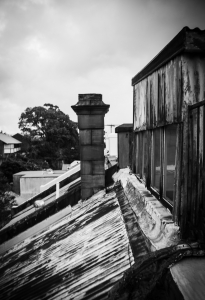Powers v. 31 E 31 LLC, a case from the New York Court of Appeals, involved plaintiff who was injured at a friend’s apartment building. After a night of drinking, plaintiff and some friends went to apartment where the accident occurred.
 While at the apartment, the group stepped through a window to access the roof deck. The window opening was nearly a foot and a half wide and a little more than two feet high. The roof area flat enough to walk on was five feet wide and extended the entire length of the building. The portion of the roof abutted the exterior wall of the next building.
While at the apartment, the group stepped through a window to access the roof deck. The window opening was nearly a foot and a half wide and a little more than two feet high. The roof area flat enough to walk on was five feet wide and extended the entire length of the building. The portion of the roof abutted the exterior wall of the next building.
At one portion of this flat roof, an airshaft separated the two buildings. The airshaft consisted of a 25-foot vertical drop with no railing or other protection to keep people from falling into the shaft. The opening of the shaft was approximately four feet by eight feet.
After plaintiff and the others spent time on the roof, the group climbed back through the window into the apartment. After some time, the group realized plaintiff was no longer with them. They soon found him at the bottom of the airshaft, unresponsive. Plaintiff suffered serious debilitating personal injury.
As our Boston premises liability attorneys can explain, landlords have a duty to warn and make reasonable efforts to protect people from foreseeable injuries from foreseeable dangers. In the Commonwealth of Massachusetts, the law does not make any distinction between licensees and invitees, as other states still do.
In Powers, plaintiff, though his guardian, filed a personal injury lawsuit against the owners and management company of the building. Plaintiff alleged defendants created and maintained a dangerous condition and acted negligent by not installing a railing to prevent foreseeable injury. It was further alleged that the failing to install a railing or other restraining device was a violation local building codes.
Defendants filed a motion for summary judgment in which they alleged the building code did not apply to this building, and the injury was not foreseeable. The trial court denied the motion for summary judgment on grounds that there was genuine dispute of material fact whether the injury was foreseeable and defendant had failed to establish the building code did not apply.
Defendant appealed and the intermediary appeals court reversed trial judge and dismissed the complaint. This court held that it was unforeseeable that people would use a window to access the roof.
Plaintiff then appealed to the state supreme court, which reversed the lower appellate court. The court held that there was a triable issue as to whether the accident was foreseeable. There is a well-settled duty of care owed by landlords to keep premises reasonably safe. It should be up to a jury to decide whether or not this was a foreseeable injury.
In cases like these, it is quite possible defendants knew people used the roof as a place for social gatherings. It is not uncommon for real estate agents to even call this type of walkable roof a roof deck.
If you are injured in an accident in Boston, call Jeffrey Glassman Injury Lawyers for a free and confidential appointment — (617) 777-7777.
Additional Resources:
Powers v. 31 E 31 LLC, August 13, 2014, New York Court of Appeals
More Blog Entries:
New Guidelines for Identifying Causes of Newborn Brain Injury, October 21, 2014, Boston Personal Injury Lawyer Blog
 Boston Personal Injury Attorney Blog
Boston Personal Injury Attorney Blog

